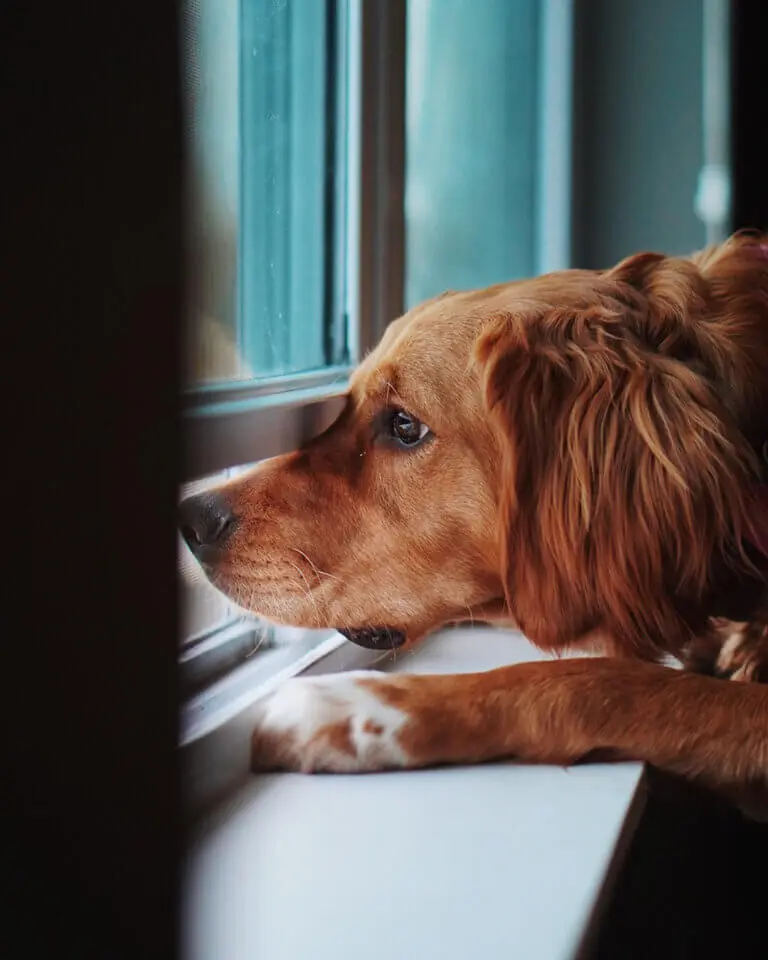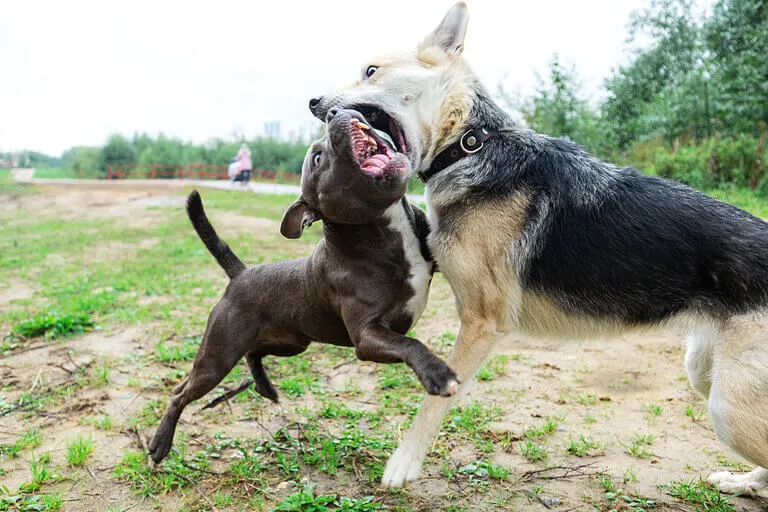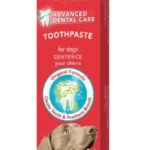When a good, playful time turns into a dreaded accidental execution, it is hard knowing what to do next. No pet owner waits for a day that their beloved pet could kill the other. Unfortunately, it might happen. So, if you are faced with the question “My dog killed my other dog, what should I do?” what next? While we hope you don’t get into this situation, here is how you can handle it.
What To Do With A Dog That Killed Another Dog?
The first thing you should do in such a situation is to prioritize safety.
1. Separate the Pets
Emotions will be running high immediately after a dog-on-dog fight that involves death. First, isolate the dog from the remaining dogs, if there are any. Use a leash and a secure location if the dog is calm enough to follow your lead. You can have them in a separate room or crate. Try to create a physical barrier between the dog and other dogs. If you notice your dog is not calm enough to follow your lead or is exhibiting aggressive behavior, avoid trying to restrain it physically. Instead, get in touch with a dog trainer to handle it.
2. Check for Injuries
Carefully check your dog for injuries sustained during the fight after securing them. Look for wounds, swellings, or signs of pain. Contact your veterinarian immediately to assess injuries that might be hard for you to see.
3. Move the Dead Dog
While it’s emotionally difficult, move the deceased dog to a separate location until you can make arrangements for a proper burial for them.
4. Contact Animal Control
Depending on your location, local animal control regulations might require you to report the incident. Check your local rules to understand the reporting requirements. Animal control may require your dog to undergo a quarantine period to ensure they are not carrying any diseases. Follow all their instructions carefully.
5. Contact a Vet
A vet will come in handy in case other pets were hurt during the attack. Discussing your observations and concerns with your veterinarian is highly recommendable. Vets understand the dog’s behavior and can tell of any underlying medical conditions.
6. Seek Support
Dealing with the loss of a pet and the aftermath of a dog fight can be overwhelming. Reach out to a trusted friend, family member, or a grief counselor specializing in pet loss.
Caring for the Deceased Dog
You will need to make arrangements for your deceased dog, sad and untimely as it may be. Luckily, there are options to help you handle this sensitive situation with respect. Your veterinarian or pet aftercare may be able to accept your pet’s remains for cremation or disposal. Some veterinary clinics offer compassionate care programs to help pet owners during this difficult time.
You can choose to transport them yourself. Alternatively, you can wrap them in a blanket and place them in a leak-proof container until you reach the veterinarian or pet bereavement service.
Why Did My Dog Suddenly Kill My Other Dog?
Like other pets, dogs have instincts. Some instincts make them result in aggression towards other dogs. The initial shock from such behavior may leave you searching for answers. Below are some common reasons why your dog might kill another dog.
Fear or Anxiety
Fearful and anxious dogs may use lashing out as a defensive mechanism. This could be triggered by unfamiliar dogs, sudden noises, or even perceived threats from their housemates. Having too many dogs living together might bring stress to other dogs. Dogs, too, experience burnout. A dog that’s undergoing stress can kill others. A good example is when dogs kill their puppies as a result of stress. It is not a new thing, and you can read this thread of dog owners on Reddit discussing this, and how they got past it.
Improper Socialization
Puppies undergo a critical socialization period during their first few months of life. Proper socialization exposes them to different people, animals, and environments. This is a technique that helps them to develop confidence and appropriate social skills.
Dogs who miss out on this crucial stage might be more prone to fear-based aggression around other dogs. Just like humans, not all dogs are best friends. Some canine personalities fail to get along. It is important to recognize incompatibility in dogs and manage their interactions accordingly.
Underlying Medical Conditions
Pain and discomfort caused by an underlying medical condition can trigger aggression in some cases. Conditions like thyroid disorders, neurological issues, or even dental pain can make a dog irritable and more likely to react negatively to interaction.
Some illnesses cause aggression. The most known is rabies. Parasitic infestation also plays a role in influencing a dog’s behavior. Dog owners should practice quarantine on dogs with underlying medical conditions.
Resource Guarding
Dogs can become aggressive when they feel threatened or stressed about losing valuable resources. Such resources may include food, toys, treats, or their favorite resting spots. This behavior can manifest in growling, snapping, or even biting.
Breed Predispositions
Certain breeds may have a higher genetic predisposition towards certain types of aggression. This doesn’t necessarily mean these dogs are inherently dangerous. It highlights the importance of proper training and socialization, especially when introducing them to other dogs.
Legal Considerations: What to Do If Someone Else’s Dog Kills Your Dog?
Losing a pet is emotionally devastating, especially when it happens due to another dog’s actions. Legal considerations may arise. Animal control regulations and laws regarding pet ownership differ across countries and states.
Some regions have strict liability laws for dog bites and attacks. This means that the owner of the dog that caused death is liable for damages regardless of their knowledge. Negligence laws apply in some areas. All you need to do is prove that the owner was negligent in handling their dog.
Many areas have leash laws mandating dogs be kept on leashes in public spaces. If the dog that attacked your pet was off-leash, you should use that as a violation to strengthen your negligence case. Similarly, local regulations regarding dangerous dogs might influence the legal situation.
Potential Legal Actions
You might be able to pursue legal action against the other dog’s owner to recover damages for:
- Veterinary Bills: If your dog was injured but survived the attack, you can get the associated veterinary treatment costs.
- The Value of Your Pet: Courts may award compensation for the fair market value of your deceased pet. Particularly if they were a purebred dog.
- Burial or Cremation Costs: Reasonable expenses for laying your pet to rest are recoverable.
- Emotional Distress: Most jurisdictions limit compensation for emotional distress caused by pet loss. You should consult a lawyer to help determine if this applies to your situation.
Other options to consider that might not involve legal action are:
- Renter’s Insurance: This applies to homeowners. Your homeowner’s insurance policy might cover damages related to dog bites or attacks. Review your policy details and contact your insurance company for coverage options.
- Reaching an Agreement: An out-of-court settlement with the other dog’s owner might be a more efficient way to recover damages. A lengthy legal battle is not worth it in some cases. You can facilitate this process through mediation with the help of a lawyer.
What Should I Do If My Dog Attacked My Other Dog and Drew Blood?
The aftermath of a dogfight where one canine sustains injuries is frightening. Seeking immediate veterinary care for both dogs is essential because both dogs might be hurt. Both dogs require a thorough examination by a veterinarian, even if the wounds appear minor, and here’s why:
- Infection Control: Dog bites carry a high risk of infection due to the bacteria in their mouths. Veterinary attention will allow cleaning and disinfecting of the wounds to minimize this risk. The vet will also likely prescribe antibiotics to prevent further complications.
- Internal Injuries: Bites can inflict serious internal damage that may not be immediately visible. Internal bleeding, organ trauma, or fractures can all occur, even with seemingly superficial wounds. A veterinarian will perform X-rays and other diagnostic tests to assess the full extent of the injuries and develop an appropriate treatment plan.
- Pain Management: Your veterinarian will administer pain medication to ensure your dog’s comfort during healing.
How to handle the situation before getting to the vet:
- Control Bleeding: Apply gentle pressure with a clean cloth or gauze pad to the wound if it is actively bleeding. Do not attempt to clean the wound or use harsh chemicals.
- Gather Information: Note any details you can recall about the fight while waiting for your appointment. Details include what triggered the fight and the severity of the visible injuries. This information can be helpful for the veterinarian.
How to handle the situation after going to the vet.
- Vaccinations: Ensure both dogs are up-to-date on their vaccinations. Particularly if any of them had rabies, this is crucial to prevent spreading diseases that can be transmitted through bites.
- Follow-up Care: Your veterinarian may recommend follow-up appointments depending on the severity of the injuries. Follow-up care will help to monitor healing and address any complications that might arise.
Euthanasia Consideration: Will They Put Down a Dog That Attacked Another Dog?
The decision of euthanasia after a dog-on-dog attack is an emotional one. There’s no simple answer, and the course of action will depend heavily on the specific circumstances. The decision of whether or not to euthanize your dog should be made in consultation with a qualified professional and not based on emotion alone. Below are the factors influencing this difficult choice.
Risk Assessment and Rehabilitation Potential
A certified animal behaviorist can thoroughly assess your dog’s behavior. This process determines the risk of future aggression. The animal behaviorist will consider factors like the severity of the attack, your dog’s history of aggression, and their overall temperament.
Rehabilitation through behavior modification training might be a viable option. This is only possible if the cause of aggression and your dog’s characteristics are manageable. A qualified professional will then be able to develop a training plan to address your dog’s underlying issues and teach them appropriate social interaction.
Factors that Influence Euthanasia Decisions
Several factors often influence the decision to euthanize after a dog attack:
- The severity of the Attack: An attack causing serious injury or death to another dog strongly indicates a high risk for future aggression.
- Prior Behavior: A history of aggression towards other dogs or people significantly increases the risk and may make rehabilitation challenging.
- Breed Predispositions: Although this is not a definitive factor, certain breeds may have a higher genetic predisposition towards aggression. Responsible ownership and training, however, can mitigate these tendencies in many cases.
Ethical Considerations
You have a responsibility to ensure that you are safe, your pet is secure, and the community is safe as a dog owner. While euthanasia is a difficult decision, it may be necessary in some situations to prioritize public safety.
Dog ownership comes with responsibilities. Suppose behavioral therapy is unrealistic due to your lifestyle limitations. In that case, euthanasia might be a more humane option instead of placing the dog in a situation where they could continue jeopardizing other dogs’ safety.
Can the Death of One Affect Another Dog?

The death of a companion can be a deeply emotional experience for all involved. We may understand human grief. How do dogs cope with the loss of another dog? Does it affect them? Yes. Dogs are significantly affected by the death of another dog they were close to.
Dogs may not express grief like humans do, but they show emotional responses following the loss of a companion. These can include:
- A previously playful dog might become withdrawn and passive. Loss of appetite or changes in sleeping patterns are also common signs.
- Some dogs may become more vocal, whining or howling more frequently. Others might become quieter than usual.
- Their separation anxiety can worsen, or new anxiety issues might develop. Your dog may become clingy or fearful, looking for their lost companion.
- Dogs who enjoy playing together might lose interest in toys or become less interactive.
- Your dog might sniff areas where their companion used to spend time, attempting to locate them.
The depth and duration of a dog’s grief will vary depending on the strength of their bond with the deceased dog. Be patient and understanding towards your grieving dog during this difficult time. Here are some ways to offer comfort and support:
- Stick to your dog’s regular feeding and walking schedule as much as possible. Routine provides comfort and a sense of normalcy during a time of uncertainty.
- Cuddle with your dog, offer gentle petting, and spend extra time engaging in activities they enjoy.
- If you have other pets, monitor their interactions closely. Introduce them gradually in a controlled environment if necessary.
- Consult with a qualified animal behaviorist if your dog’s behavioral changes are severe or persist for a long time. They can provide guidance and support during the grieving process.
What to Do with Two Dogs After a Fight?
The aftermath of a dogfight between your pets will leave you wondering if a harmonious co-existence is possible. The decision depends on the severity of the fight and the underlying causes. You can establish a harmonious co-existence by reintroducing your dogs with professional guidance and careful management.
The safety and well-being of your dogs should be your top priority. Attempting to reintroduce your dogs without professional help increases the risk of further altercations. A certified animal behaviorist can assess the situation and develop a reintroduction plan for your dogs.
Factors Influencing Reintroduction
Here are some factors a behaviorist will consider when creating a reintroduction plan:
- Severity of the Fight: A vicious attack suggests a higher risk for future aggression, making reintroduction more challenging.
- Underlying Cause: Identifying the trigger for the fight is crucial for addressing the root of the problem and preventing future incidents.
- Temperament of Each Dog: A calm and submissive dog might be more easily reintroduced than two dominant personalities.
- Your Experience Level: Reintroducing dogs requires consistent management and training skills. The behaviorist will assess your comfort level and ability to follow the plan.
The Reintroduction Process
A professional reintroduction plan involves several gradual steps, such as:
- Keeping the dogs separated with crates, leashes, or separate rooms for initial safety.
- Utilizing muzzles and leashes during controlled interactions provides another layer of safety and control.
- Rewarding calm and positive interactions between the dogs to help build positive associations and encourage tolerance.
- Gradually exposing the dogs to each other’s sights, smells, and sounds in a controlled manner. This practice helps them become accustomed to each other’s presence without fear or anxiety.
Considering Rehoming
Reintroducing the dogs may not be possible in some cases. Here are some indicators that rehoming might be the most responsible course of action:
- If one dog exhibits persistent predatory behavior towards the other, rehoming may be necessary to protect the vulnerable dog.
- If the required management techniques are too restrictive or unrealistic for your lifestyle, rehoming might be a kinder option for both dogs.
Winding Up
Dogs can become aggressive to each other for a variety of reasons. It is a rare occurrence for a dog to attack another without provocation. If it happens quite regularly, it’s time to seek professional help. Losing a dog to another one is a sad experience, but chances are it all begins with something that can be prevented.





